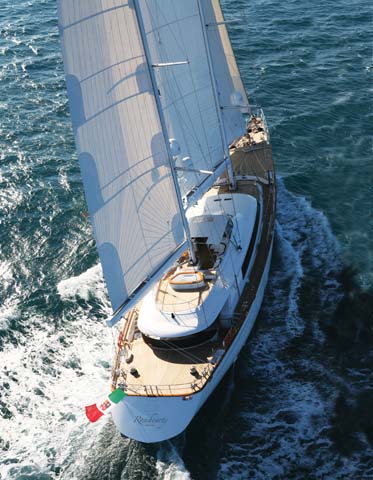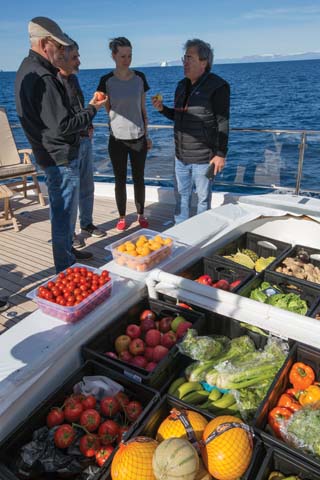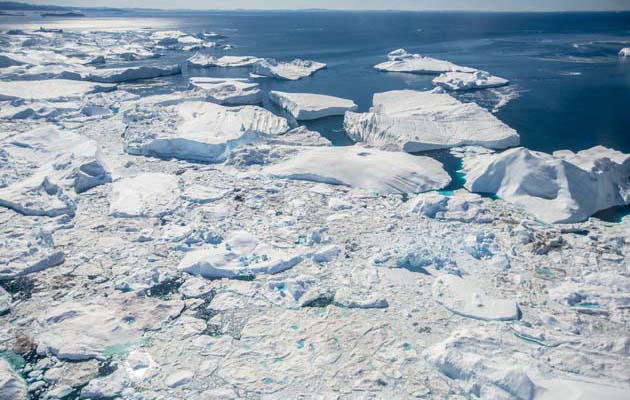A trip to the North West Passage was the culmination of ten years’ planning for the 56m Perini Navi Rosehearty. As Captain David Hutchinson tells us, it was worth the wait. Photos by Peter Ralston and Richard Smith.
“The owner has always had an interest in history, especially the North West Passage – one of his big heroes was Shackleton, and this had been discussed and planned for probably over ten years.
Really it’s the fulfilment of a long held desire to go up there,” reports David ‘Hutch’ Hutchison, captain of Rosehearty.
Hands-on advice for cruising in ice – expedition to Greenland
Rosehearty left Newport, Rhode Island on 1 July last summer, heading north to Nuuk, on south-west Greenland, exploring the fjords and Kangia Glacier. They then crossed Baffin Bay to the Canadian archipelago, sailing through Pond Inlet and north to Beechey Island and Resolute Bay, then through the Bellot Straits as far west as Fort Ross, before retracing their steps to Greenland and south.
Besides the owner, eight guests and crew, Rosehearty was joined aboard by additional local guides.
“We had a couple of Canadian guides which we had to have, and one was a logistics expert and one was a naturalist. We had a Canadian ice pilot, because to go up there in a boat of our size you have to have a licensed ice pilot.”
The ice pilot was Captain Toomey, who has made 27 voyages to the Canadian Arctic, including 11 complete transits of the North West Passage.
“He is legendary in the world of ice navigation,” comments Hutchison. “He taught the Canadian Coastguard ice breaking division. Most of the captains that are out there today went through his training. While he’s 80-something you would never have known it. He’s definitely a good guy to have on board.
“We ran three senior officers on each watch. With it being 24-hour daylight up there a lot of the times we would be running for 48 or 72 hours and we would just rotate through.
“When we got close to, or into, fog and ice conditions, or if there were icebergs in the water, Captain Toomey would always be on hand.”

Captains Toomey and Hutchison guide Rosehearty through the often unchartered areas.
Ice avoidance
Despite the expertise on board, navigation still proved less than straightforward. “I think the most physically challenging thing was navigating in uncharted waters that are ice-strewn.
“I know that’s a bit of cliché but the charts up there are indicative so we’d be going along expecting to be in 100m of water and suddenly find ourselves in 12 or 14m. Then we’d take maybe three or four hours to make a detour and find our way across whatever was under the water.
“At first you’d think the depth gauge is erroneous, but we didn’t want to test it to see if it was…
“We carried a 7m RIB with twin Yamahas on it and any time there was a question, and our ice pilot hadn’t been there before and didn’t know the exact approach route, we would send the RIB in and we would follow it.
“The issues are that in some of the anchorages there was ice in the water and high current, and you know when the tidal streams reverse the ice just flows back into the anchorage. So you can’t stay there in case an iceberg grounds over the top of your anchor and you’d never be able to get it back up.
“They don’t tend to move very quickly or very often when they do ground, so that was always something that was in the back of our mind. Once or twice we did have to scramble to get out of a place before it got a little bit too risky.”
Transatlantic in a catamaran – from Reykjavik to Newfoundland via Prince Christian Sound Greenland

Dwarfed by the landscape of Dundas Harbour, an abandoned settlement in Nanavut, on the Canadian shore.
Hutchison says that despite the dramatic photographs of icebergs from their trip, they ran a zero-risk policy. “We made a conscious decision not to touch any ice whatsoever.”
“We’re in an aluminium boat so we worried about every [size of iceberg]. Basically if we could see something the size of a sofa it was probably about 300-400 tonnes,” he explains, citing the rule that icebergs only reveal one eighth of their volume on the surface, with the rest concealed below.
“So when we were in the worst parts of ice, nobody was taking photos, nobody was flying drones, we were just concentrating on finding the next leap forward.
“When this all started to happen it was getting later in the season and we were so used to 24-hour sunlight by then, but by the middle of August [you] start to get dusk.
“Silver water and silver ice with grey clouds over the top, everything becomes fairly monochrome and in those conditions you’ve just got to say: ‘We’ve got to wait here until conditions improve and we can actually see where we’re going.’
“We’ve got an 8-10mm thin aluminium hull, and if you hit a piece of ice it’s not going to take much to damage that.”

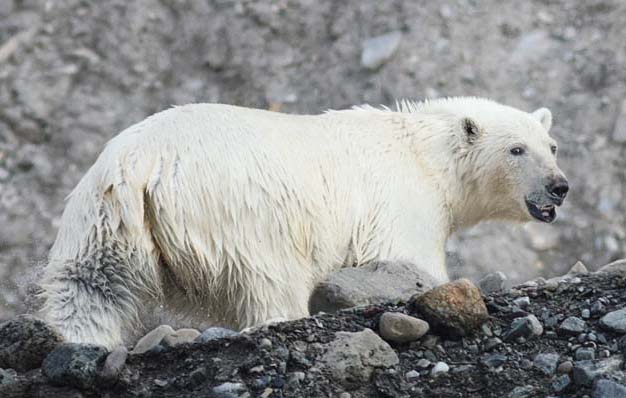
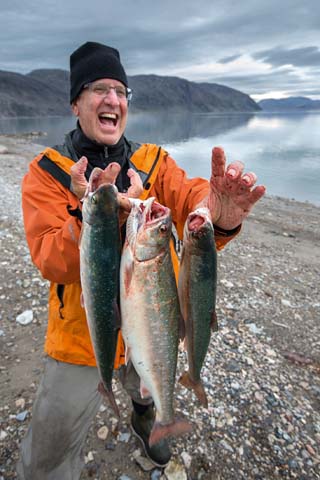
The rewards, however, proved more than worth it – almost complete solitude, and the opportunity to see some of the rarest wildlife on earth.
“We would get upset when we saw another boat on the AIS, which has a range of about 30-40 miles. Once or twice we did bump into mini cruise ships which have about 60-80 people on. But the rest of the time the area was ours,” Hutchison recalls.
Although the original plan had been to continue west through the North West Passage across to Alaska, the schedule was changed early in the trip.
“There’s a very short weather window, six weeks max, and we decided not to proceed down from Cambridge Bay and along the Northern Territory coast,” comments Hutchison. “That left us more time to spend up there in the Canadian archipelago, which is the most beautiful part – I’m led to believe – of that part of the world.

“It’s certainly where all the animals are. Having spent a month up there looking for polar bear, whale and narwhal and belugas and walrus, it is surprising how few there are.
“The word tundra really does capture it – there are no insects, and because there are no insects there are only a few sea birds, there’s not that much marine life.
“We did see beluga whales. The polar bears were definitely there and we were always aware of them – they’re fairly hungry at this time of year so we had to be especially careful of the polar bears.
“It’s a bit like going on safari, we saw the big three: [the] narwhals and we saw polar bear and walrus. We also saw musk ox, which are more prevalent in Greenland, sort of big shaggy Neanderthal-like Highland cattle!”
One highlight of the trip was meeting the local Innuit, who proved to be incredibly welcoming to the crew of the 183ft superyacht. “The people are beautiful in personality, and just so excited to see anybody,” he comments.
“I don’t think if we’d turned up in a kayak it would have made any difference to our reception. It was just that we were one of the first – or maybe the first – boats they’d seen in ten months.
“We were slightly ahead of the resupply ships that come in every year. You’ve got to imagine that if you are an Innuit you have to decide how big your kids are going to grow in the next year, and order all the clothes and all the things you may need for them and your family a year ahead of time because that ship only comes once a year!”

We were the first new faces any of the local Innuit had seen for a while, as we were a few weeks ahead of the resupply ship
Staying snug
The resupply ship is critical in a region where air freighted food is astronomically expensive – Hutch cites an additional £15 per gallon of milk in freight charges. Provisioning for 24 people on board for six weeks was, therefore, something of a logistical challenge.
“We were more self sufficient than we thought we would be. But we did a couple of little modifications to the boat – we took the Jacuzzi which was outside and turned it into an outside fridge, which was always kept cold because we would go and chip off blocks off icebergs. All of our root vegetables and hard fruits were kept up in that.
“The other thing we found was that the bilges were actually colder than the fridges, because the lower part of the boat was uninsulated.
“The inside of the boat was fine, toasty warm, we never had any problems even when it was -4°C, -6°C, -8°C and very icy outside.
“The flybridge we modified to put an enclosure on it. We ducted the heat up from the inside of the boat, and it was always 14-15°C so you could be up there without a jacket. They were the only real changes we did to the boat, plus enclosing the aft cockpit to make it a big lounge.”

Conditions were unusually fair during the six weeks Rosehearty spent in the North West Passage over July and August 2016. “I think next year there will probably be more ice in the water because it melted further into the ice that hasn’t melted in years, and some of that has moved down and refrozen, so that will probably be in play next year,” explains Hutchison.
“The first year ice always melts – that’s why they call it first year ice, because every year it refreezes to the same extent, but the really dangerous and difficult stuff to identify is the second- and multi-year ice which doesn’t melt and is far more dangerous to you. So it was a pretty unique year. It could have been so much harder.”
Unfinished business
“It kind of gets into your soul,” says Hutchison, who before the trip talked to the few other captains who had made a similar voyage for advice.
“Every single one of them wanted to go back as soon as they could. I have left with the same empathy for the place.
There is so little there, the air is so clean and clear, the horizons are so vast. I can only liken it, visually, to being on a boat cruising up the Grand Canyon with the topography either side of you at 2,000-3,000m tall.”

The impact of the environment was felt across the crew and guests. “I think people became a lot more reflective. It wouldn’t be that unusual to see somebody bundled up in three or four layers, hats and gloves, sitting in a deckchair outside just staring at the horizon.”
Hutchison says plans are being considered for a return trip for Rosehearty, this time maybe approaching from the west via Pitcairn and the coast of Chile, even Antarctica.
“We work regularly in the Caribbean and the Mediterranean, we’ve been all over the world. Indian Ocean, Pacific, New Zealand and Australia, but you can’t really compare going to the Arctic.
“I’d put Greenland right up there. Greenland is beautiful and much more accessible maybe than further north. But we billed it as once as a lifetime, and if we’re lucky we might get to go up and spend another few weeks there.”

Captain David Hutchinson
Captain David Hutchison, or ‘Hutch’ as he is known, has been a professional yacht captain for 35 years with over 650,000 sailing miles worldwide as master. He has captained six Perini Navi designs and has been with Rosehearty for the last 18 years. He loves sailing and exploring and says the North West Passage expedition was a true goal and a privilege to be part of.

